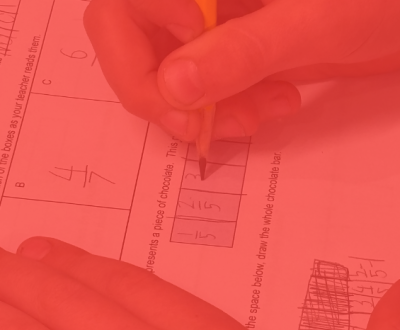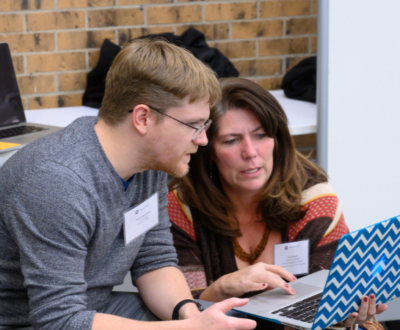Embrace Slow, Human-Centered Assessment
- May 3, 2024
- Blog
In a world that is moving at hyper speed, “slow” movements embrace quality over speed. Slow foods, tourism, and other initiatives encourage slowing down the pace of life. Instead of striving to do things faster, the slow movement focuses on doing things better.
At Forefront Education, we host an open-source math assessment called the Universal Screeners for Number Sense (USNS). For schools inundated with computer-based assessment options, these interview-based assessments can seem old-fashioned; however, educators that use them are consistently impressed with how much information can be gathered when we “slow” the assessment process down.
Rather than speeding through the assessment process and leaving teachers to puzzle over color-coded student rankings, slow the assessment process down and focus on doing it well. Here are 3 tips for slow assessment practices that will empower teachers with high-quality information to improve instruction:
Tip 1: Reveal more than an overall score
Most assessments provide an overall score so that you can see what students know. This can be great information for the students that “get it”: it indicates that teachers can continue on with instruction to the next topic. But for the students that did not demonstrate overall mastery? More information is needed.
Better assessments provide alignment to specific learning targets, so that you can understand the key concepts and skills that students have mastered. The best assessments provide this alignment at the item or performance task level, offering multiple data points to track students’ progress toward mastery.
Tip 2: Provide insights into student thinking
Assessments that don’t just show what students know, but also reveal how they are thinking about a particular problem or task, provide much more actionable information that can guide instruction.
For example, was it a misconception that led to a missed response? Or did the student simply lack focus or rush through the assessment? By observing how students respond to assessment tasks, and even better, tasks that reveal student thinking, teachers are able to know if a missed response is an indicator of a lack of understanding or another issue.
Tip 3: Are inclusive by design
Sometimes students may not fully understand the instructions for a particular task, leading to comprehension errors that result in missed responses. English Language Learners are particularly susceptible to these types of errors.
Other assessments that are fluency based are often timed. Whether for reading or computational fluency, fluency-based assessments encourage students to get down answers, rather than to think. They are also assessments that do not consider the diverse needs of learners in the classroom who may require additional accommodations and cannot simply speed through assessment tasks.
What “slow” assessment looks like
If you have about 3 and a half minutes, check out this math interview with a kindergartner and see how much you learn about this student with this interview-based assessment.
In a few minutes, teachers can gain a wealth of information about a learner, including starting places for instruction and an understanding of the child’s strengths. If using these interviews for intervention groupings, teachers will be able to develop groupings based on those students identified as at-risk or more flexible groupings based on specific needs.
In the few minutes it takes to sit down with young learners and present them with tasks, we share with them so many important values:
-
- We share that we value them as learners, and we care to understand what they know.
- We share that we value early numeracy and the specific concepts and skills we find important at that time of year in their grade.
- We share that we value the process of assessment, and how it is essential for our students to reserve time to demonstrate understanding.
In this way, this fulfills the primary purpose of universal screening — identify students at-risk of poor learning outcomes — in a relatively short period of time. It also achieves additional purposes, such as informing instructional responses. But perhaps most importantly, teachers devote time to build the student-teacher relationship and communicate values with students.
You can learn a lot about a student in just 3 minutes.
Assessment as communication
How many times over the pandemic have we found that the quality of communication suffered in the shift to remote forms? Virtual meetings, emails, and chats offer quicker, more convenient forms of communication, but this is not efficiency. Sometimes, an in-person meeting, even with the time it takes to get into the same room, provides a quality of communication unsurpassed by the various methods of remote communication tools.
The same is true for assessments. Assessments are, first and foremost, a method of communication. We use assessments to enable students to communicate what they know and can do. There are many reasons educators need this information: to provide formative information to guide instruction, for grades, to monitor the effectiveness of their instruction, to support family communication, and much more. This communication is critical for the work of teachers, schools, and school districts.
There has been a massive effort over the past 2 decades to improve online assessments. Having students sit in front of computers to have assessments automatically scored has been seen as a way to save people time and to collect data seamlessly; however, the process of sitting beside our students to listen to them, observe them, and learn about what they can and can’t do can not yet be replicated by computer-based assessments. Teaching is a human-centered profession, and assessment remains the cornerstone of how we communicate and listen to our students.
Conclusion
When using digital assessments, teachers may feel they receive broad stroke information about overall student performance. Certainly, sending kids to the computer lab for 20 minutes is a quick way to gather learning data. At best, this information simply confirms what teachers already know without providing diagnostic-level information to inform next steps. The questions on these assessments are unknown, leaving teachers with imprecise information about where students performed well and where to offer additional supports.
At worst, and particularly for the youngest learners, teachers and support staff devote significant resources to improve the validity of their results. This often involves support staff working 1:1 with students during assessment windows. At the same time, they do not provide opportunities to gather data about the most important, foundational skills that cannot yet be assessed well digitally. In all scenarios, even with beautiful, color-coded reports, student thinking and problem-solving strategies remain hidden and learning is reduced to a percentile score.
As you plan for next school year, consider how you can embrace slow assessment practices. Assessments that reveal more than an overall score, but also show specific skills that students have mastered or need support with, are high-quality assessments. Opportunities to see student thinking alongside performance information helps teachers better respond to test results and use the information to guide instruction. And lastly, assessments that are inclusive by design make sure that your classrooms provide equitable opportunities for all students to demonstrate what they know and do not yet know.
About Our Work
Forefront, an assessment data solution, makes assessment results from slow and fast assessments easy-to-collect and visualize, helping your teachers and leaders focus on the most meaningful insights into student learning. Our reports and data visualizations make assessment data and the insights they can generate accessible from the classroom level to the central office. Explore a 3-minute overview or connect with our school partnerships team today to learn more.
About us and this blog
Our team and tools help schools implement standards-based grading, streamline assessment systems, and use meaningful data to drive decision-making.
Free K-6 Math Screener
The Universal Screeners for Number Sense (USNS) assessments are interview-based and pencil and paper K-6 math screeners designed by teachers to assess for students' number sense. This open-source project provides free, high-quality assessment tools to over 9,000 schools in the US and internationally. Learn more and access your free copy below.
More from our blog
See all postsForefront is the only assessment data solution optimized for classroom assessment results, leveraging these results to fuel instruction, PLCs, and grading. Elevate meaningful assessment data district-wide to transform how you understand and communicate about student learning across your schools.
Copyright © 2025 Forefront Education, Inc. All Rights Reserved.








